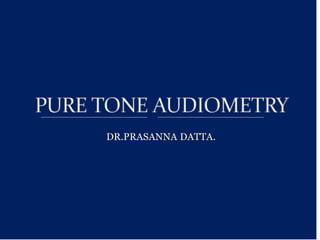
Pure Tone Audiometry
- 2. PURETONE SOUND When an object vibrates in fixed single frequency, the sound waves will present a sinusoidal wave pattern knownassine-wave. Thesound sensation produced by sucha sine-wave is called asapure tone sound. In pure tone audiometry, we test the hearing sensitivity of asubject only for pure tone sounds.
- 4. AIMS OF PURE TONE AUDIOMETRY Whether the subject hasany definite hearing loss. Whether the hearing loss is conductive/sensorineural/mixed type. In sensorineural deafness,wheatherthe deafness is cochlear orretrocochlear. Tonote the degree of hearing dysfunction.
- 5. PURE TONE AUDIOMETER It is the electronic deviceused for creating pure tone audiogram. It consists of an audio-oscillator which generates pure tone soundsof different frequencies. Eachtone can be separately amplified to a maximum of 100to 110dB in most frequencies except very low & very high frequencies. Audiometer is connected to standard & specified bone conduction vibrator or earphones through which sound is presented to subject’s ear.
- 7. THRESHOLD The International Standards Organisation has defined hearing threshold as“the lowest sound pressure level, at which under specified conditions, aperson gives apredetermined percentage of correct responses on repeated trails”. For clinical usage, thispredetermined percentage is50%. In pure tone audiometry,we try to obtain thresholds that compare the hearing sensitivity
- 8. THRESHOLD of asubject in decibels with afixed ideal or normal hearing level(0dB). So, in clinical audiometry,it is the relative threshold & not the absolute threshold that is measured. That means, in audiological measurements, the intensity of sound is always measured & expressed in comparison to or in relation to another sound which is ideal normal hearingthreshold.
- 9. DECIBEL & OTHER RELATED TERMS TheDecibel isthe unit by which the intensity of the sound(or pressure exerted by asound stimulus) ismeasured. Average minimum which will producea sound just audible to anormal ear:- In units of pressure0.00024 dynes/sq.cm. In units of intensity 1/100000000000000000 watts/sq.cm.
- 10. DECIBEL & OTHER RELATED TERMS BEL-Aratio expressedin logarithm(with base 10)which tells ushow many times the sound we are measuring is stronger or weaker than areferencesound.(0-14) [BEL=log IO/IR] DECIBEL-one tenth ofBEL. [DECIBEL(dB)=10 logIO/IR] SPL-signifies that apressure reference has been used(i.e. referencesound has apressure level of .00024dynes/sq.cm.)
- 11. DECIBEL & OTHER RELATED TERMS HL-In different frequencies the intensity or the pressure of just audible sound is slightly different. Hencefor standardisation, different amount of pressure(or intensity) have been separately calculated for each frequency, such that the minimum sound audible by a normal subject in different frequencies may be designated as0 dB HL, for that particular frequency.
- 12. SL-This is in reference to the auditory threshold of aparticular subject & indicates how much sound sensation that particular subject is actuallygetting. SL+handicap=HL. DECIBEL & OTHER RELATED TERMS
- 13. PROCEDURE OF P.T.A. AIRCONDUCTIONTESTS(conditions required):- 1.CALIBRATIONOFTHEINSTRUMENT- ISO-1964specification. 6 monthly electroniccalibration. Air conductionheadphones-TDH39/TDH49. Insert ear-phones-ER-3A. Ear conductionhead phone cushions-MX 41 AR.
- 17. PROCEDURE OF P.T.A. 2.REASONABLYNOISELESSTEST ENVIRONMENT- American standardsAssociation(ANSI-53.1- 1991)table. ISO/DIS 8253table. 3.POSITION OFHEADPHONES. 4.INSTRUCTIONTOTHEPATIENT.
- 18. PROCEDURE OF P.T.A. TECHNIQUEOFAIRCONDUCTIONTESTS:- 1.CONVENTIONAL/ HUGHSON- WESTLAKE(5-up-10-down) technique. 2.American Speech &Hearing Association(ASHA)technique. 3.British Society of Audiology/British association of Otolaryngologists technique. 4.ISO/DIS 8253technique.
- 20. PROCEDURE OF P.T.A. BONECONDUCTIONTESTS(conditions required):- 1.Calibration of the instrument-Radio ear B71. 2.Reasonably noiseless test environment. 3.Placement ofbone conduction vibrator- a)Mastoid placement- Superior in respect of sensitivity by 10-15dB. The bone conduction vibrator is placed over the mastoid bone attached to aspring metal headband. The pressure on mastoid is given as 500gm/sq.cm.
- 21. PROCEDURE OF P.T.A. Area over which the person canhear the sound loudest isplaced. The testing ear is kept uncovered.The other ear is kept covered formasking. The bone conduction vibrator must not touch the pinna or the earphone. b)Frontal placement-Superior in respect of consistency because of lessvariation of amount of tissue between bone conduction vibrator & the earphone. TECHNIQUESOFBONECONDUCTION.
- 22. MASKING In pure tone audiometry, the clinician must ascertain the exact hearing threshold by air & bone conduction for the different frequencies for each of the two ears separately & individually. This can not be taken lightly & needs to beover-emphasised. Contralateral masking means introducing a noisein non-test ear,suchthat the non-test ear is acoustically blocked & can not participate in the hearing test.
- 23. MASKING When to mask:- Interaural attenuation(40-45 dBHLfor air conduction). Hazard of crosshearing is much more in bone conduction than in air conduction test. Chanceof cross-hearing isAC(testear)- BC(non-test ear)>IA. Forbone conduction, the Interaural attenuation may be 0 dBHL.
- 24. MASKING How much to mask-neither undermask,nor overmask. Minimum maskinglevel: (AC)Air conduction threshold in the test ear- 45+(Air conduction threshold in the masked ear-Bone conduction threshold in the masked ear). Maximum maskinglevel: Boneconduction threshold for the test ear+45.
- 25. MASKING Masking is doneby: 1.Whitenoise-consistsof soundof all frequenciesfrom high to low. 2.Narrow bandnoise-more effective for masking, consists of anarrow band of noise 100-200 Hz above/below that frequency. 3.Complex noise-low frequency fundamental+multiples offrequencies up to 4000 Hz.Least efficient for masking.
- 26. A) QUANTITATIVEINFORMATION- 1.What is theACthreshold? 2.What is theBCthreshold? 3.What is theA-B gap? 4.Wheather masking hasbeen done or not? 5.Doesit match with clinical findings and tuning forktests? B)QUALITATIVEINFORMATION. INTERPRETETION OF P.T.A.
- 31. SENSORINEURAL DEAFNESS ACthreshold>30 dB. BCthreshold>20 dB. A-B gap<20dB.
- 32. MIXED DEAFNESS ACthreshold>45 dB. BCthreshold>20 dB. A-B gap>20dB.
- 37. LIMITATIONS OF P.T.A. 1.AUDIOGRAMSAREVERYOFTEN INACCURATE. a)Improper technique- masking,placement. b)Improper testcondition-RNTE. c)Improper test instrument-calibration. d)Improper examiner. 2.ASUBJECTIVE&TIME-CONSUMINGTEST. 3.ITDOESNOTASSESSALLFEATURESOF HEARING.
- 38. LIMITATIONS OF P.T.A. 4.ITDOESNOTIDENTIFYTHENATUREOF THEPATHOLOGY. 5.BONE CONDUCTIONTESTDOESNOT ASSESSTHETRUESENSORINEURAL RESERVE. 6.MANY SOURCESOFVARIANCESIN THE TESTRESULTSTHATARENOTRELATEDTO HEARING.
- 39. HAVE A GOOD DAY